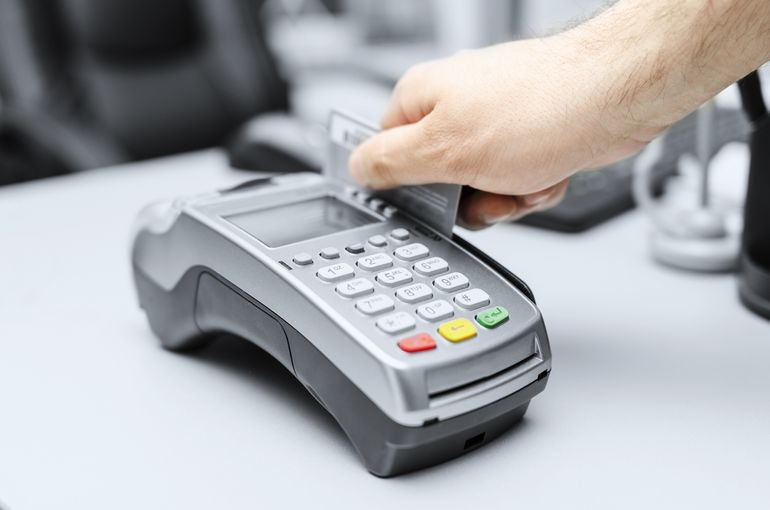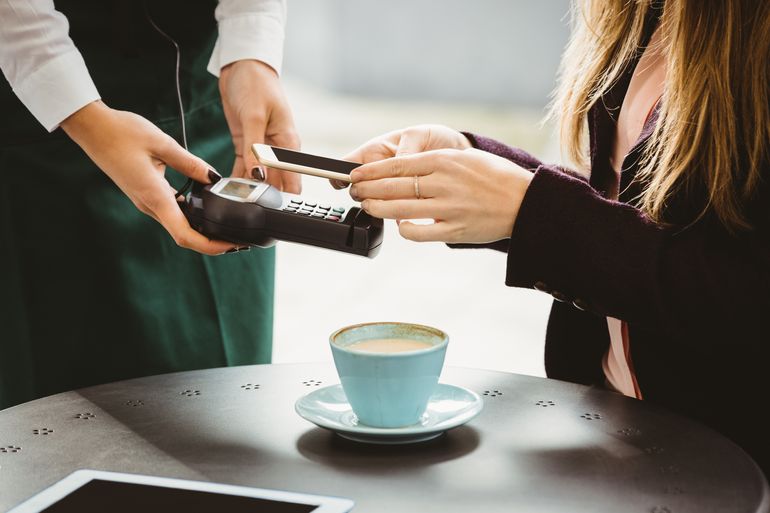What do bell bottoms and the magnetic stripe (aka magstripe) payment technology have in common?
They’re both out of style.
Back in the late 1960s, flared “hippie” pants started making their way into the wardrobes of even the most moderate dressers. Around the same time, AMEX cards were outfitted with a magstripe for a quick and easy way to swipe and pay. It was an innovative alternative to the “knucklebuster” credit card processors of the day.
As the ‘60s turned into the ‘70s, pants got wider and wider. And by 1980, Visa and MasterCard got on board with the magstripe.
And then fashion evolved, branching out from bell bottoms to parachute pants and skin tight leather looks that defined a new era of style.
And the magstripe? Not so much. The technology wasn’t significantly altered in any way for four decades, putting it squarely in the same category as bell bottoms – out of date.
In this article, we’ll take a deep dive into the difference between magstripe and EMV technology, including their individual histories, benefits, and disadvantages. Then we’ll show you why EMV might be better for your business.
Let’s see what magstripe and EMV payments each bring to your restaurant’s tables.
Disclaimer: All of the information contained in this article is for informational purposes only and does not constitute legal, accounting, tax, or other professional or compliance advice. It is your responsibility to determine whether credit card surcharging is permissible in your jurisdiction. You are solely responsible for ensuring that your activity is compliant with the card network requirements and all laws applicable to you. Non-compliance may result in regulatory consequences or fines.
The Impact of Magstripe Technology
Despite its failure to progress, the magstripe propelled the credit card industry into the 21st century.
U.S. credit card balances grew from $9 billion at the beginning of 1973 to $796 billion in 2011, according to Marcia Frellick of creditcards.com. Some even credit the magstripe for the widespread popularity of card payments over cash.
Even though the magstripe is still widely used, there are more advanced ways to make a purchase with a credit card. Namely, chip cards – or EMV (Europay, Mastercard, and Visa) – which have become the gold standard for credit card payments.
Surprisingly, the U.S. is one of the slowest countries in the world to adopt chip technology. However, with the security and convenience benefits EMV provides, it’s gaining traction.
Most restaurants that accept credit and debit cards use payment processing terminals that process magstripe cards. The vast majority of these processors can also accept EMV or chip technology, but some restaurant owners are reluctant to turn on that functionality. However, as banks begin to phase out magstripe cards in favor of more secure payment methods, businesses will have to reconsider.
All About Magstripe
When AMEX first introduced the magstripe, it was considered a game-changing addition to the payment world. Developed by an IBM engineer, the company even named it one of its 100 most important contributions to society!
How the Magstripe Operates

The magstripe is a black stripe on the underside of a card that uses modified iron-based magnetic particles to transmit data between the strip and a credit card terminal. Although payment terminals have changed over time, the magstripe’s basic mechanism operates essentially the same way now as it did in its early days. Here’s how it works:
- A card is swiped through a terminal, which reads the cardholder’s financial information on the magstripe
- The terminal transmits an authorization request to the acquiring bank (the bank the payment processing company uses to route payments)
- The terminal sends an authorization request to the issuing bank, e.g. Visa or MasterCard
- The terminal coordinates an authorization from the issuing bank to the acquiring bank – and a response from the acquiring to the issuing bank
- The transaction is complete, and the client signs the receipt to close out the sale
While the transaction seems like a complex process, it generally takes mere seconds to complete. This is why the magstripe was celebrated when it first came on the market. It was quick, easy, and freed the consumer and merchant from administrative hassles and messy paperwork.
Disadvantages of the Magstripe
Increased Risk of Fraud
The main drawback with the magstripe is its inability to keep information safe. Every time a card is swiped, it’s lumped into the merchant’s huge pool of transactions. This means the data on every card is not secure – and can be taken and used for future (fraudulent) transactions. Cards can even be counterfeited using a “skimmer” machine, which is cheap to buy or make
And if a cardholder reports fraud, it’s very difficult – if not impossible – for the merchant or credit card processor to isolate when, how and by whom the security breach took place.
Increased Cost for Merchants
This increased risk of fraud means payment processing companies charge merchants higher credit card fees for transactions that are completed with a magstripe.
All About EMV
Now it’s time to address the pressing question of what is EMV?
Most credit and debit cards today are outfitted with a microchip. This is EMV, which is developed and managed by American Express, Discover, JCB, MasterCard, UnionPay, and Visa. The computer chip provides an extra layer of security for cardholders and merchants. Unlike magstripe, each chip transaction is assigned a code so fraudulent charges are easier to isolate. This has helped to significantly reduced credit card fraud in restaurants.
How the Chip Card Operates
In addition to the additional security benefits, EMV also provides more choice when it comes to paying. Transactions with a chip card include:
Dip and Sign
- A card is inserted into the credit card reader, which reads the cardholder’s financial information
- The terminal transmits an authorization request to the acquiring bank (the bank the payment processing company uses to route payments)
- The terminal sends an authorization request to the issuing bank (like Visa or MasterCard)
- The terminal coordinates an authorization from the issuing bank to the acquiring bank, followed by a response from the acquiring to the issuing bank
- The transaction is complete, and the client signs the receipt to close out the sale
Chip and PIN
- The customer inserts their card into the payment terminal and enters a four- to six-digit PIN (a code is assigned to the transaction, making it easy to find in case of fraud)
- The terminal transmits an authorization request to the acquiring bank (the bank the payment processing company uses to route payments)
- The terminal sends an authorization request to the issuing bank (like Visa or MasterCard)
- The terminal coordinates an authorization from the issuing bank to the acquiring bank, followed by a response from the acquiring to the issuing bank
- The transaction is complete – no signature required!
Tap
- The customer taps their card and information from the microchip in the card is transmitted through the radio frequency antennas found in credit card readers to authorize the purchase
- The terminal transmits an authorization request to the acquiring bank (the bank the payment processing company uses to route payments)
- The terminal sends an authorization request to the issuing bank (like Visa or MasterCard)
- The terminal coordinates an authorization from the issuing bank to the acquiring bank, followed by a response from the acquiring to the issuing bank
- The transaction is complete – no signature or PIN required!
Tap is considered even more secure than the chip and PIN method because the cardholder hangs on to the card at all times. It can only work in short range, so information can’t be picked up to create a counterfeit card. The customer’s name, bank account number and three-digit security code on the back of the card are never transmitted during transactions.
Digital Payments
Near field communication (NFC) has changed the game for digital payments. Customers with a mobile wallet (a smartphone app that securely stores the bank details of a credit or debit card), can hover their phone – with the app open – over the payment terminal to authorize mobile payments the same way they would tap their card. There’s no need to enter a PIN or sign a receipt.
Mobile wallets are considered the safest way to pay because the consumer’s card is encrypted by the app and locked behind the phone’s security features. In order to access their mobile wallet, a person has to unlock or use facial recognition to open their phone. This ensures that a lost or stolen phone won’t lead to credit card fraud.
Pros and Cons of EMV

Benefits of EMV
The main advantage of chip cards is the extra layer of security. EMV cards are designed to prevent fraud by assigning individual codes to every transaction. A fraudster would need expensive, sophisticated equipment to extract the banking information on a chip card.
Disadvantages of EMV
Not all chip cards are created equal. Some cards are limited to Dip and Sign (no PIN or tap capability). This is the least secure method of EMV payment.
Some restaurants and stores don’t use EMV. If someone wants to pay with their chip card, but the merchant’s payment processor can’t facilitate that kind of transaction, they must resort to the magstripe. This brings back the security risks associated with the outdated technology.
Why EMV Compliance Is Better for Business
If you’ve been holding off on flipping the switch to accept EMV payments, here are some great reasons to make the change today:
- You’ll reduce the risk of fraud in your restaurant. With chip cards, there’s simply less risk of fraud for both you and your customers. Since magstripe cards are magnetized, it’s easier for your information to get lifted and applied to a new card. Chip cards can’t be lifted as easily.
- You’ll pay less in payment processing fees and also save money on your monthly credit card statements! Transaction fees for EMV payments are lower than magstripe purchases.
- You’ll offer better customer service. People today expect both choice and convenience. By offering them the option to pay by dip and sign, dip and PIN, tap, or mobile payment, you’re making it easy for them to do business with you – on their terms.
- Your tables will turn over faster. Servers no longer have to make multiple trips to the table to drop off the bill fold, pick up the bill fold, process the credit card transaction, and wait for a signature before closing out the sale. With EMV technology and integrated payments, a transaction can be completed quickly and easily at the table.
Just like bell bottoms, the magstripe served a great purpose – for a time. But as fashion and technology evolve at an accelerated rate, it’s important to adapt to the best modern solutions available.
Your restaurant business and your customers deserve the best security, convenience, and choice when it comes to payment processing. Investing in the right restaurant merchant services provider today is an investment in your future.
Learn how to save money on payment processing fees







